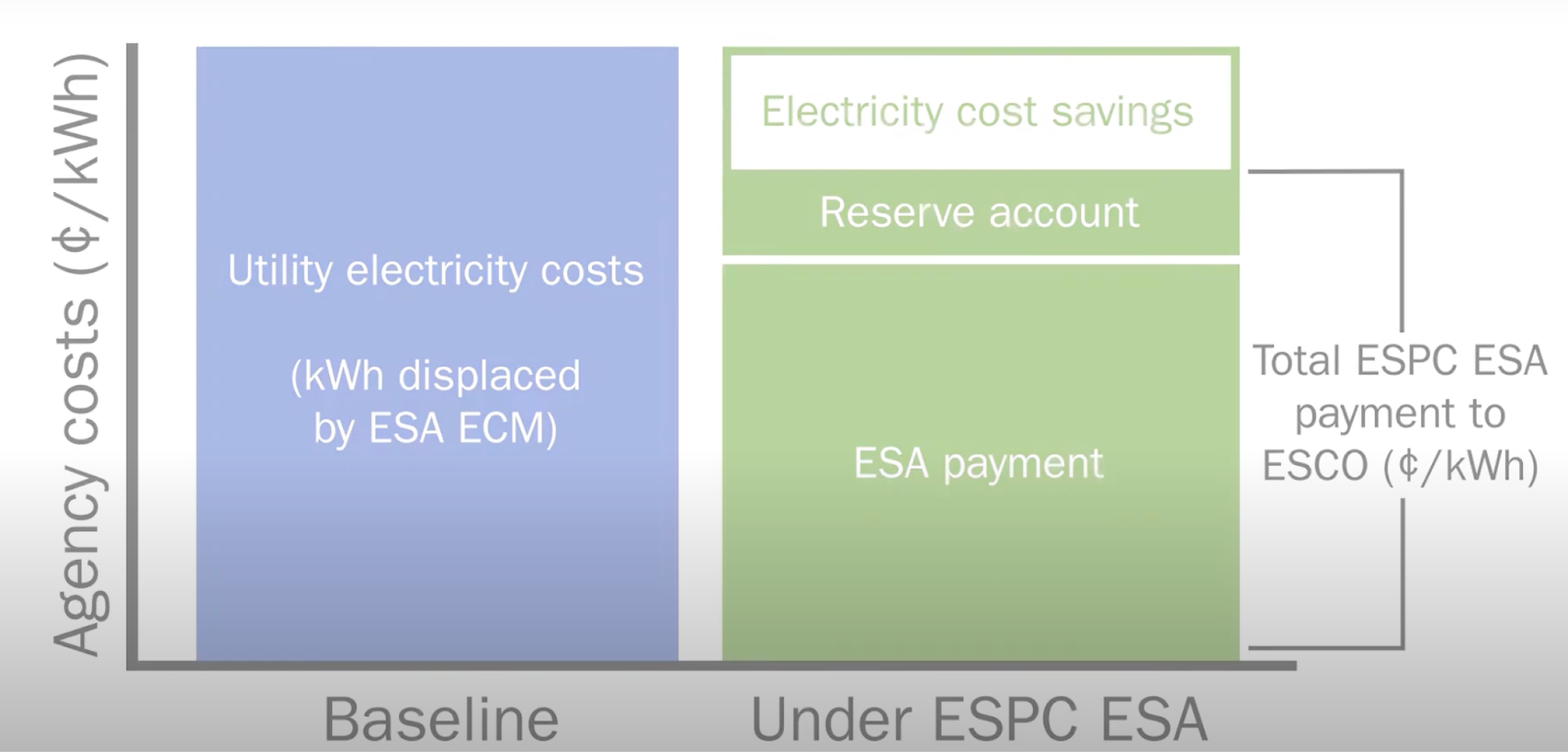
50 Years, $50 Billion in Savings: Don’t Pull the Plug on FEMP
When it comes to energy use, no one tops Uncle Sam. With more than 300,000 buildings and 600,000 vehicles, the Federal Government is the nation’s largest energy consumer. That means any effort to conserve power across federal operations directly benefits taxpayers, strengthens national security, and reduces emissions.
Since 1975, the Department of Energy’s (DOE) Federal Energy Management Program (FEMP) has been leading that charge. Born out of the oil crisis and authorized under the Federal Energy Policy and Conservation Act (1975), FEMP has quietly transformed how the federal government uses energy, helping agencies save money, modernize infrastructure, and meet ambitious energy goals.
FEMP has been backed by bipartisan support across administrations. In recent years, a bipartisan group of Senators hailing from states across the country—from Hawaii, to Ohio, to New Hampshire, and West Virginia—cosponsored legislation to formally authorize FEMP and establish energy and water reduction goals for federal buildings in an effort to reduce emissions and save money.
Over time, FEMP’s role has expanded to include a wide range of Congressional mandates: from helping agencies leverage funding for infrastructure modernization, to tracking agency accountability, to offering cutting-edge technical assistance. But perhaps its most powerful achievement isn’t written into statute: FEMP saves the federal government billions of dollars.
In fact, FEMP has done the unthinkable: it’s achieved a “50/50/50.”
Over the past 50 years, FEMP has delivered:
- A 50% reduction in federal energy intensity
- $50 billion in cumulative energy cost savings
- And this year, it marks its 50th anniversary

Since 1975, FEMP has helped agencies reduce the energy intensity of their facilities by 50%.
So what’s behind these staggering savings, and how can FEMP build on its legacy of efficiency to meet the challenges of the next 50 years? That is, if its operations aren’t wound down, as DOE leadership has proposed for FEMP in the FY2026 budget.1
The AFFECT Program: Investing in Smarter, Cleaner Government
When it comes to saving taxpayers money while cutting emissions, few programs punch above their weight like FEMP’s AFFECT program—short for Assisting Federal Facilities with Energy Conservation Technologies.
Launched a decade ago, AFFECT provides competitive grants to help federal agencies implement energy conservation, clean energy, and net-zero projects. These grants help agencies overcome a common obstacle: the lack of upfront capital to fund energy infrastructure improvements. By filling that gap, AFFECT empowers agencies to invest in long-term savings and resilience.
The results speak for themselves. Over the program’s lifetime, AFFECT has funded 160 projects, distributed nearly $300 million, and leveraged a staggering $4 billion in private-sector investment—yielding $137 million in cost savings to date.
These projects align with longstanding federal priorities to reduce costs, support American manufacturing, enhance energy resilience, and strengthen national security—all of which have gotten increased attention recently. AFFECT proves what’s possible when strategic funding meets real agency needs: a cleaner, more efficient, and more resilient federal government.
The Power of Performance Contracts
One of FEMP’s most impactful tools over the past 50 years has been its championing of performance contracting—a financial model that allows federal agencies to upgrade their energy systems without spending a dime in upfront Congressionally-appropriated funds.Through mechanisms like Energy Savings Performance Contracts (ESPCs) and Utility Energy Service Contracts (UESCs), FEMP helps agencies partner with private-sector energy service companies (ESCOs) to design and install energy-saving improvements. The best part? The cost of the upgrades is repaid over time using the guaranteed energy savings, so taxpayers benefit from day one.

A graph that shows how ESPCs reduce agency costs by providing electricity cost savings.
These contracts have helped the federal government leverage billions of dollars in private capital, reducing emissions, modernizing aging infrastructure, and cutting utility bills at no upfront cost.
But FEMP hasn’t stopped there. Many civilian agencies don’t have the legal authority to sign long-term power purchase agreements (PPAs)—a key tool for procuring clean energy from the private sector for agency use. In response, FEMP developed a specialized contracting model: the Energy Savings Performance Contract with an Energy Sales Agreement (ESPC ESA). This innovative tool gives agencies a PPA-like pathway to procure their own distributed energy technologies—like solar installations, solar hot water, wind turbines, geothermal, and combined heat and power.
Here’s how ESPC ESAs work:
- Start with a plan. The agency figures out what kind of clean energy system they need and then hires a private energy company, called an ESCO, through a competitive process.
- The ESCO builds it—and owns it (at first). The ESCO designs and installs the system and owns it during the contract. Because it’s privately owned, the ESCO can use tax incentives that federal agencies can’t access—like the Investment Tax Credit (ITC)—which helps lower the total cost. However, if Congress rolls back clean energy tax credits like the ITC in the June 2025 reconciliation bill, it will limit one of the smartest tools we have to deliver lower-cost energy upgrades in federal facilities, ultimately costing taxpayers more to achieve the same results.
- Agencies only pay for the energy they use. Once the system is up and running, the agency pays the ESCO for the electricity it generates—and only that electricity. The rate must be cheaper than what the agency would’ve paid the utility, which means guaranteed savings.
- Eventually, the agency takes ownership. A small slice of each energy payment goes into a savings account that covers the cost of transferring ownership. By the end of the contract (usually within 20 years), the agency owns the system outright—and keeps the clean energy flowing.
So, the federal government gets to invest in reliable energy systems with no upfront cost, guaranteed savings, and long-term benefits. This approach blends financial flexibility with long-term energy independence, offering a win-win for agencies and taxpayers alike.
And the results are real. In FY 2023 alone, FEMP supported 191 federal projects that reported $566 million cost savings annually—with actual savings exceeding projections at 101% of estimated values.
Performance contracts aren’t just a workaround for limited budgets—they’re a core strategy for delivering cleaner, more resilient, and more cost-effective government operations. With these tools, FEMP is helping agencies meet today’s energy demands without waiting on tomorrow’s appropriations.
FEMP in Action on Public Lands: Naval Station Newport
FEMP’s commitment to smart stewardship extends beyond office buildings and into the heart of America’s public lands and military installations. At Naval Station Newport in Rhode Island, a 2023 FEMP-led energy and water “treasure hunt” uncovered significant savings opportunities, demonstrating how thoughtful management protects both the federal budget and the government’s consumption of public resources.
The treasure hunt—a hands-on, facility-wide assessment—identified measures projected to save $144,000 annually in energy costs while reducing greenhouse gas emissions by 288 tons per year. These findings not only highlight a direct benefit to taxpayers through reduced utility bills but also contribute to the Navy’s broader goals for energy resilience and resource stewardship.
By deploying FEMP’s technical expertise and leveraging innovative assessment techniques, Naval Station Newport took an important step toward more efficient operations. This case exemplifies how efficient energy management on public lands protects vital federal resources, enhances mission readiness, and supports America’s energy abundance goals.
Why FEMP Matters Now More Than Ever
The federal government is facing a perfect storm of challenges: the urgent need to cut carbon emissions, historic infrastructure investments in need of implementation, rising energy costs, and a shrinking federal workforce stretched thin. At the same time, global demand for electricity is projected to double by 2050. Meeting these demands without breaking budgets or burning out public servants will require solutions that are smart, scalable, and already proven.
That’s where the Federal Energy Management Program comes in.
For five decades, FEMP has helped agencies modernize their operations, cut waste, and unlock billions in savings. FEMP delivers what every taxpayer hopes for: a government that spends wisely, thinks long-term, and achieves true efficiency. As the next chapter of energy and infrastructure development unfolds, FEMP deserves recognition—and reinvestment. However, despite its proven track record, DOE’s fiscal year 2026 budget proposal requests $8 million to wind down activities at FEMP—potentially shutting its doors for good. That’s a mistake. For decades, FEMP has helped federal agencies save billions in taxpayer dollars, reduce energy waste, and strengthen mission resilience, all without expanding bureaucracy or growing the deficit. If we’re serious about decarbonizing the federal footprint, lowering costs, and building a more resilient future for all Americans, then we need to look to—and continue funding—the programs and public servants who have been doing that work for decades.
The new alignment signals a clear shift in priorities: offices dedicated to clean energy and energy efficiency have been renamed, consolidated, or eliminated, while new divisions elevate hydrocarbons, fusion, and a combined Office of AI & Quantum.
In a new report, we begin to address these fundamental implementation questions based on discussions with over 80 individuals – from senior political staff to individual project managers – involved in the execution of major clean energy programs through the Department of Energy (DOE).
Achieving energy abundance requires reforming electricity markets, refreshing electric utility regulation and rethinking the way we pay for grid infrastructure.
Slashing research and development programs across the DOE, all while Congress rolls back clean energy tax incentives and programs, is not going to solve the nation’s energy emergency. It makes our current challenges even worse.